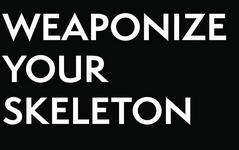Mama Said Knock You Out: Women in Hand-to-Hand Combat Training

When a bullet enters an eye, there’s nothing in that interaction that is affected by the gender of the person who pulled the trigger. The universe doesn’t stop and check to see if it was a man or a woman before allowing the chunk of metal to tear through soft tissue — the only question in the cold equations is “Does the energy exceed the tissue’s ability to deform without disruption?” Will it bounce, or stick?
Likewise, the question of gender doesn’t matter to the newly blind person, and the first responders dealing with the casualty don’t care about the chromosomal makeup of the shooter. Gender has no bearing on the energy interaction event — either there was enough “oomph” to wreck anatomy, or there wasn’t.
The truth about violence is that people are machines that can be broken and shut off, and the person reflected in the patterns of head-meat is inconsequential in the face of raw physics. In other words, if you engage with the person you’re in a fight for your life; if you engage with the single square inch of anatomy it’s just about delivering a beating.
Don’t mistake the ability to deliver a beating with the ability to take a beating, or to overpower someone — which is what we think of when we think of “fighting.” The poisonous idea that violence is about going toe-to-toe and trading blows in a contest of durability and strength — like rams butting heads — reinforces the belief it’s something women can’t do, or at least that they need special classes, tailored to their gender, in order to have any hope for survival.
While a big, strong man can “take a beating” (endure non-specific trauma) it’s a different story with a ruptured eyeball. Or a collapsed airway. Or a knee folded backwards. The average adult female weighs more than enough to do all of that work — the universe only cares if the burst rating of the anatomy in question was exceeded or not. If the cold equations math out, it’s broke.
We don’t differentiate between genders in this work because gender has no impact on the raw physics. A finger in the eye is a finger in the eye, chromosomal makeup or identity notwithstanding.
As of this writing, the last two people who had to use this information were female; both were in life-or-death situations, and both handled it with specifically applied blunt force trauma — two injuries each to achieve nonfunctional states — and both walked away as the winners. They weren’t bigger, faster or stronger than the men they put down — they just knew where to apply the forces they were capable of generating. They didn’t waste any time or effort on trying to defend themselves or “fight for their lives.” They just hurt people — the very definition of “dangerous.”
One of the things I’ve learned in my 28 years of teaching is that while the men we train have to navigate the stupid dance of intermale aggression, it’s the women, on balance, who end up having to use violence for survival. Women know truths about our society that men can barely intuit (often being the unwitting perpetrators of inequality, if not outright predators themselves) and so women show up for training with a much more sober outlook on what’s at stake. They know it’s not a game, and that they can’t afford to screw it up — this makes them get better, faster than their male counterparts, something many men find frustrating, especially in a husband and wife team where the wife is doing far better than the husband at this thing that is ostensibly the epitome of manliness. The best thing for everyone in this situation is to drop the social stuff and focus on the mechanics where we all meet in the middle.
At our most recent weekend seminar I had two participants thank me, one right after the other, notable because of the social distance that separated them: the first, a man, a former police officer who had just returned from a decade of contract work in the Middle East (precisely the kind of person one would expect to find at a course like ours); the second, a woman, a brave survivor of some truly harrowing violent experiences. Both reported that they got a lot out of the course and appreciated it a great deal, something that didn’t surprise me as they were both well-versed in the realities of violence before they set foot on the mats. Upon later reflection it occurred to me that what made this significant was that they both took the same course, at the same time. We didn’t alter the course for their assumed social and gender roles — it wasn’t “women’s self-defense” or “manly combatives” — it was applied physics and physiology, the use of violence as a survival tool, the place where all of us, as vulnerable meat machines, are rendered starkly equal.
This is why women who train with us report that while they may have been initially reluctant to hit the mats (our lack of sugarcoating repels everyone), once they realized it was just physics and physiology — stuff that’s always on and available to everyone — they wanted more. I’ve seen the most unlikely people — people who would never in their wildest dreams imagine themselves in a “hardcore” hand-to-hand combat course — engage calmly and coolly in the ancient work of pure survival, pressing a head to the mats to slot a knife into the carotid, for example. And so someone who showed up because they were afraid of what might happen to them is too busy doing to remember that initiating fear. What was once terrifying is now a tool held firmly in the fist.
While there are things we could do to make the course more appealing to women (and men, for that matter), that would require wasting time talking about things that just don’t matter. Our lack of pandering isn’t about making everyone “tough it out” equally, but about the fact that the social stuff we think about all day, every day, just doesn’t matter when the skeleton, driven by mass in motion, penetrates the eye socket. We don’t care about societal norms and minor differences in plumbing because the cold equations don’t care, either.
Here’s what our female instructors and the women we’ve trained want you to know: regardless of what the world tells you, if you want to do this, you can.
— Chris Ranck-Buhr


The truth!! This makes so much sense
See also: It’s Different for Me: A Woman’s Perspective on Hand-to-Hand Combat Training
“two injuries each to achieve nonfunctional states — and both walked away as the winners”
You misspelled “survivors”. Competition has winners and losers, and the distinction in that context is usually (but not always) unambiguous. Violence has perpetrators, victims, and survivors, and the distinctions in this context are sometimes unambiguous (eg last one standing is usually the survivor) and often ambiguous (eg sometimes a survivor can feel like a victim, sometimes a victim can feel like a survivor).
No one “wins” violence. Winning violence is like winning an earthquake, or a hurricane. The goal is to survive, ideally with minimal damage/losses, not win.
Anyway, I do love your writing. I hope you don’t mind me giving you a hard time over this point.
Thanks for commenting, and for your kind words.
You’re absolutely right: violence is corrosive—no one involved emerges unscathed.
However, in this context (violence against women), “survivor” has clear connotations to socialized people: a victim who lived through the experience. And so I chose “winner” as a rhetorical placeholder in order to differentiate how they felt about what they had done. While traumatic, they felt that the experience—taking control via injury to end the encounter on their own terms—was ultimately a positive one.
In the paradigm of perpetrator-victim-survivor we must think and train to be perpetrators. This is not socially acceptable, but when we strip away the social veneer, and everything reverts to a state of nature, it makes perfect sense. There is no other choice. And in the cases cited above it was not a perpetrator and their victim who turned out to be a survivor, but two perpetrators of violence colliding until one walked away.
Much simpler to encapsulate all that with the inadequate and ill-fitting “winner” than it was to engage in a bunch of additional hair-splitting. In writing, as in violence, protraction loses the punch.
I suppose the long version of that does “lose the punch” within the context of the story, but as a footnote to the story, I find it very helpful. Thanks again.
Agreed! That’s what the comment section on our blog is for: to unpack things that are otherwise glossed over, share perspectives, and footnote the hell out of the original piece.*
Really appreciate your thoughtful participation!
*As opposed to the standard function of Internet comment sections, which apparently serve as abbatoirs for the lancing of misanthropic boils.